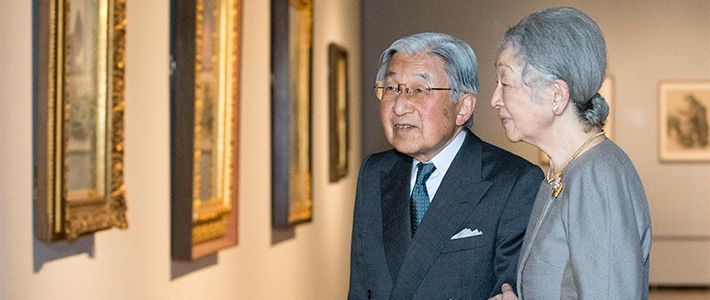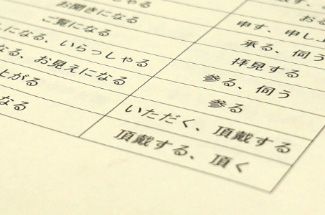
Talking About The Emperor in Japanese
Culture- English
- 日本語
- 简体字
- 繁體字
- Français
- Español
- العربية
- Русский
A Higher Keigo
When service assistants talk to customers in Japan, they show courtesy by using honorific language, known as keigo. If the customer is king, appropriate deference is required. A discrepancy in rank—whether in a brief service interaction or within a company—brings into play different vocabulary than that used in casual, everyday conversation. It can take time even for a Japanese graduate new to the work environment to learn to use it appropriately, to say nothing of a foreign learner of the language.
This is one level of keigo, but what if the person you are speaking to actually is king—or emperor? Above standard honorific language, there is another level known as saikō keigo used when talking to or about those of exalted rank. It is applied to both the Japanese imperial family and foreign royals—although not to presidents and other nonroyal heads of state—and was also formerly required for the shōgun, regents, and other powerful nobles.
As with the standard form of honorific language, saikō keigo has its own distinct nouns, verbs, and other words that substitute for everyday vocabulary. These once appeared extensively in newspapers and radio reports about imperial activities. Since the end of World War II, however, the highest form of honorific language has largely disappeared from the media. A few words remain, nonetheless, as representatives of this reverential form of speech.
Majesty and Highness
Emperor Akihito is referred to in Japanese as tennō heika (天皇陛下). This could be translated as “his imperial majesty,” or more literally “his majesty, the emperor.” The word heika here is the most commonly used saikō keigo in Japanese today. The courtesy title is only given to the emperor and empress, the empress dowager (the wife of the previous emperor when she survives her husband), and—theoretically—the grand empress dowager (the empress from the generation before that), although there has not been a Japanese grand empress dowager for centuries.
Other members of the imperial family are formally addressed as denka (殿下). For example, Crown Prince Naruhito in Japanese is kōtaishi denka (皇太子殿下). If heika is roughly equivalent to “majesty” in English, denka can be thought of as “highness,” the English rendering of this term preferred by the Imperial Household Agency. These courtesy titles are not universally required for most of the imperial family, however, and the standard honorific sama is also regularly seen and heard in the media. The exception is the emperor, who is always tennō heika and never sama.
When Emperor Shōwa passed away on January 7, 1989, almost all Japanese newspapers printed the word hōgyo (崩御), a word meaning “demise” in saikō keigo. Only a handful, including the Japanese Communist Party’s Shimbun Akahata, chose not to do so. Undoubtedly, the desire to show particular respect in referring to the death of an emperor has helped to preserve this “highest honorific” term in the language when many others have fallen out of use.
In October 2016, the Sankei Shimbun used the uncommon word kōkyo (薨去) to describe the passing of Takahito, Prince Mikasa, the uncle of Emperor Akihito. Other newspapers, however, used the standard honorific term seikyo (逝去).
“Jewel Voice Broadcast”
Another saikō keigo word that still has some currency is gyōkō (行幸), which is used when the emperor leaves the palace to travel somewhere. Often this is seen in the variant gyōkōkei (行幸啓) for when the emperor and empress go out to make a visit together. If they are setting off on a rail journey, they are driven along a road named Gyōkō-dōri that runs between the Imperial Palace and Tokyo Station. (A short list of terms used to describe imperial journeys can be found on the Imperial Household Agency website, in Japanese only.)
An imperial journey to several locations is known as a junkō (巡幸). Most famously, Emperor Shōwa traveled all over Japan after World War II. With the backing of General Douglas MacArthur and the Supreme Command for Allied Powers, the emperor set off on a series of junkō that would ultimately take him to every prefecture in Japan, except Okinawa, which was then under US military rule. These started in 1946 and were completed in 1954 when he visited Hokkaidō.
▼Further reading Japan’s Honorific Language About More Than Manners An overview of keigo, with a handy chart of commonly used verbs in all their polite forms. Japan’s Honorific Language About More Than Manners An overview of keigo, with a handy chart of commonly used verbs in all their polite forms. |
Another historic use of saikō keigo associated with Emperor Shōwa is the gyokuon hōsō (玉音放送) or “jewel voice broadcast” on August 15, 1945, in which he announced to the Japanese people that the country had surrendered to the Allied Powers. Not only was this a significant occasion in itself but it was also the first time the emperor’s voice was broadcast on the radio—the linguistic gulf between emperor and subjects, however, meant that many listeners found his speech difficult to understand. Some media outlets have revived the gyokuon hōsō phrase for Emperor Akihito’s video message concerning abdication, broadcast in August this year.
Although it now lives on mainly as part of the set phrase gyokuon hōsō, “jewel voice” or gyokuon was once in standard use to describe the speech of the emperor. Similarly, the imperial face was called ryūgan (竜顔, dragon’s face). Instead of the humdrum verb suru, “to do,” the emperor’s actions were described using asobasareru, and so on. There are countless examples to be found in language texts and history books, but today only people closely associated with the imperial family are able to use this language fluently.
Learners of Japanese need not concern themselves with more than the few basic words introduced here. It is fascinating to consider, however, how this parallel form of the language offers another step of complexity above standard honorifics.
(Banner photo: Emperor Akihito and Empress Michiko at an exhibition of the works of Kuroda Seiki at Tokyo National Museum on May 11, 2016. © Jiji.)